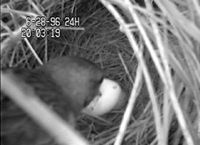In most
birds and
reptiles, an
egg (Latin
ovum) is the
zygote, resulting from fertilization of the ovum. It
nourishes and protects the embryo.
Oviparous animals are animals that lay
eggs, with little or no other development within the mother.
This is the reproductive method of many
fish,
amphibians and reptiles, all birds, the monotremes, and most
insects and arachnids.
Reptile eggs, bird eggs, and monotreme
eggs, which are laid out of water, are surrounded by a
protective
shell, either flexible or inflexible.
The 1.5 kg
ostrich egg contains the largest existing single cell
currently known, though the extinct Aepyornis and some
dinosaurs had larger eggs. The bee hummingbird produces the
smallest known bird egg, which weighs half a gram. The eggs
laid by some reptiles and most fish are even smaller, and
those of insects and other invertebrates are much smaller still.
The study or collecting of eggs, in particular bird eggs,
is called
oology.
A baby
tortoise emerges from a
reptile egg.
|
Insect eggs, in this case those of the
Emperor Gum Moth, are often laid on the
underside of leaves.
|
Fish eggs, such as these
herring eggs are often transparent and are
fertilized after laying
|
An average
Whooping Crane egg is 102 mm long, and
weighs 208 grams
|
Bird eggs
Usually after fertilization, the bird egg is laid by the
female and is
incubated for a time that varies according to the species;
then a single young hatches from each egg. Average clutch
sizes range from one (as in
condors) to about 17 (the
Grey Partridge). Some birds lay eggs even when not
fertilized, and it is not uncommon for pet owners to find
their lone bird nesting on a clutch of infertile eggs.
Shell structure
Eggs are usually smooth, but there are exceptions. A
cormorant's egg, for example, is quite rough and is very
chalky. In contrast,
tinamous have very shiny eggs, and
ducks have oily and waterproof eggs. Another variation
is the very heavily pitted eggs of
cassowaries.
There are tiny
pores in the shells of eggs to allow the unborn animal
to breathe. The
domestic hen's egg has around 7500 pores.
Shape
Most bird eggs have an
oval shape, with one end rounded and the other more
pointy. This shape results from the egg being forced through
the
oviduct. Muscles contract the oviduct behind the egg,
pushing it forward. The egg's wall is still shapeable, and
the pointy end develops at the back side. Highly conical
eggs are often seen in cliff-nesting birds. They are less
likely to roll off, tending instead to roll around in a
tight circle, and thus are believed to have been selected
for by evolution. In contrast many hole nesting birds have
nearly spherical eggs.

Brown-headed Cowbird eating another bird's
egg
Predation
There are numerous animals that feed on eggs. Principal
predators of the Black Oystercatcher's eggs, for example,
include raccoons, skunks, mink, river and sea otters,
gulls,
crows and
foxes.
The
Stoat (Mustela erminea) and Long-tailed Weasel (M. frenata)
steal ducks' eggs. Other mammals, like humans, also eat bird
eggs. The egg-eating snakes (genera Dasypeltis and
Elachistodon) specialize in eating eggs.
Brood parasitism also occurs in birds when one species lays
its eggs in the nest of another. In some cases, the host's
eggs are removed or eaten by the female, or expelled by her
chick. Brood parasites include the cowbirds and many Old
World cuckoos, most famously the Common Cuckoo.
References
See also
-
Oology - the study or collecting of eggs.




